Malcom McLean was born a farmers son on 14 November 1913, in Maxton, North Carolina, USA. He graduated from high school in 1935, but despite his ambitions, his parents could not afford to send him to college. However, fate had much in store for McLean who, in that same year, co-founded the McLean Trucking Co with his siblings, Clara and Jim. Despite the pressure of the Depression, the three siblings fought on to build the company into one of the biggest trucking enterprises in the country. Prior to the development of the standardised shipping container most cargo was transported in boxes, barrels, drums, crates and bags to destinations across the globe. Most of this cargo was unloaded and loaded onto ships by hand. Considering that approximately 200,000 pieces of freight could be loaded onto each ship, the unloading and loading process was extremely time-consuming and hence led to high shipping costs.

Cargo loading before 1956. (Source: State Library of South Australia.)
During a routine delivery of cotton to a port in Carolina in 1937, McLean had to watch and wait for hours until his entire load of cotton had been loaded manually by ship hands onto the ship. Malcom began to look outside the box for a more productive alternative. Malcom’s original idea was to load the entire truck with cargo onto the vessels, but McLean realised that while reducing loading times, this would not be efficient due to the amount of wasted space. Mclean eliminated the truck chassis and simultaneously developed an innovative way to ‘stack’ the remaining truck containers on top of each other. Storage space was dramatically improved, efficiency increased, costs reduced, and profits soared.
In 1955, McLean sold his share of McLean trucking and bought the Pan Atlantic Steamship Company. The following year Malcom bought and converted two World War II tanker ships, the first of which set sail with 58 metal containers and 15,000 tonnes of petroleum on board. The company eventually changed its name to Sea-Land as competition began to increase.
In the late-1960s, the business was booming when Malcom started his transpacific shipping line and launched his first transatlantic service. By 1969, Sea-Land was the largest container carrier in the industry at which point he sold the business for USD 530 million. Malcom tried his hand at real estate for a while but returned to his passion in 1978 when he took over the struggling United State Lines. The business subsequently rivalled Sea-Land with a fleet of 4,400 container ships but eventually faltered after Malcom acquired several huge Econships’ and gravely miscalculated their profitability.
Containerisation dramatically reduced the cost of trade because of increased efficiency and time saved during the loading and unloading of cargo from ships. The hand-loading of loose cargo onto a vessel in the mid-1950’s cost USD $5.86 per tonne, but by 2006 this price had dropped to 16 cents per tonne. It was the Vietnam War that drove his expansion into Asia, and the shipping industry was revolutionised as more and more ports adjusted to accommodate containers and container ships.
The proliferation of container ships and the reduction in shipping costs boosted international trade and continues to support global business today. In 1984 President Ronald Reagan acknowledged McLean for his vision and “spirit of determined optimism.” Malcom McLean fundamentally changed the shipping industry, and his innovation continues to silently impact the industry even today.


